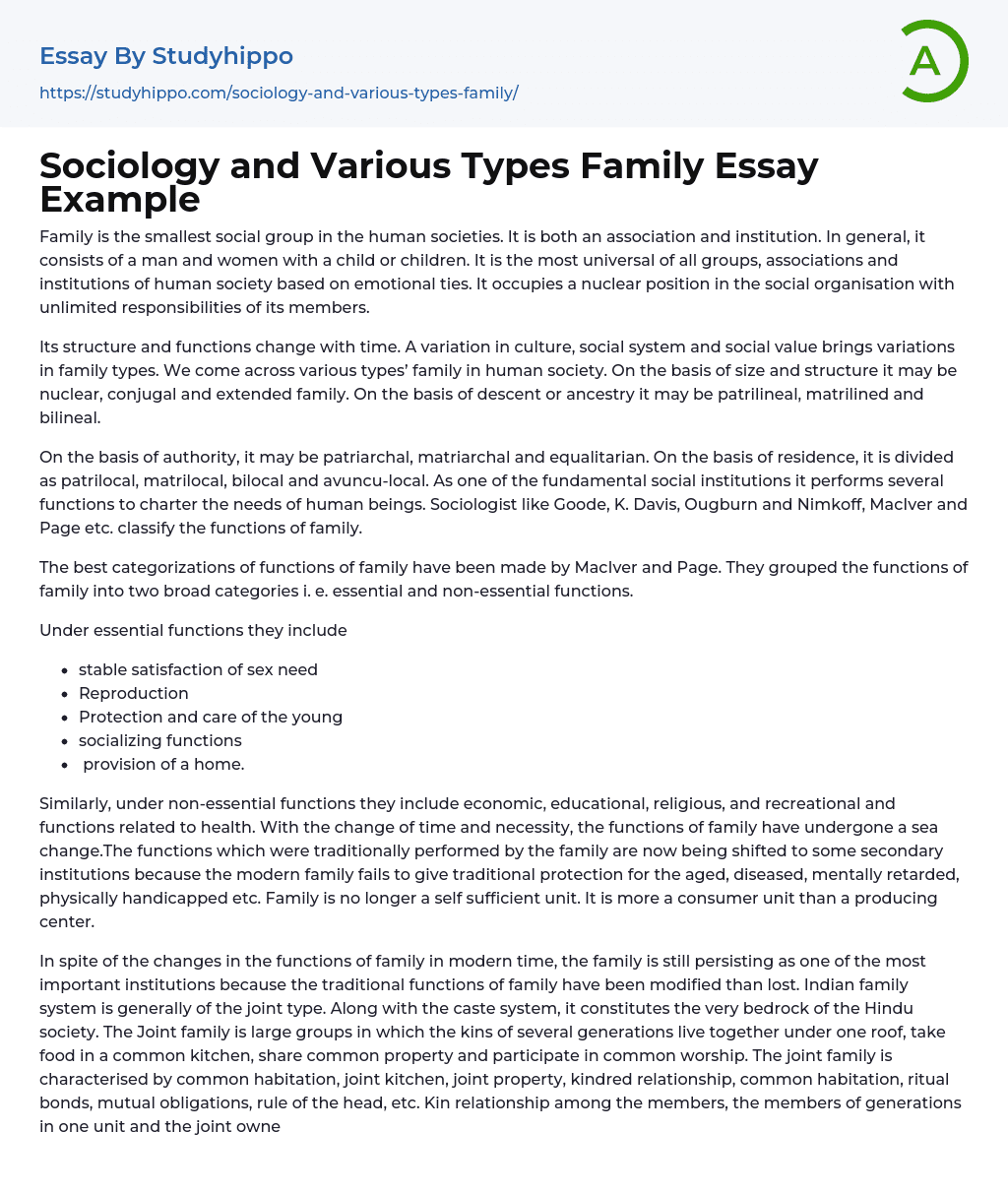Family, the most universal of all groups, associations, and institutions in human society, is the smallest social group. It is simultaneously an association and institution comprised of a man and a woman with one or more children. Its foundation lies in emotional ties.
The family holds a central position in social organization and its members have endless responsibilities. As time passes, the structure and functions of the family change. Different types of families emerge due to differences in culture, social systems, and social values within a society.
Regarding size and structure, families can be classified as nuclear, conjugal, and extended. Concerning descent or ancestry, families may be patrilineal, matrilineal, and bilineal. In terms of authority, families can be patriarchal, matriarchal, or equalitarian. Moreover, families can be categorized based on residence as patrilocal, matrilocal, bilocal, or avuncu-local. As a crucial social institution, the family serves multipl
...e functions to meet the needs of human beings. Sociologists such as Goode have studied this extensively.
Several authors, including Davis, Ougburn, Nimkoff, MacIver, and Page, have classified the functions of family. However, MacIver and Page have provided the most comprehensive categorization. According to them, the functions of family can be divided into two main categories: essential functions and non-essential functions.
Under essential functions they include
- stable satisfaction of sex need
- Reproduction
- Protection and care of the young
- socializing functions
- provision of a home.
Similarly, under non-essential functions they include economic, educational, religious, and recreational and functions related to health. With the change of time and necessity, the functions of family have undergone a sea change.The functions which were traditionally performed by the family are now being shifted to some
secondary institutions because the modern family fails to give traditional protection for the aged, diseased, mentally retarded, physically handicapped etc. Family is no longer a self sufficient unit. It is more a consumer unit than a producing center. In spite of the changes in the functions of family in modern time, the family is still persisting as one of the most important institutions because the traditional functions of family have been modified than lost.
The Indian family system is predominantly of the joint type and serves as the foundation of Hindu society alongside the caste system. The joint family consists of large groups where multiple generations of relatives live together under one roof, sharing a common kitchen and property, and participating in communal worship. The distinguishing features of a joint family include communal living arrangements, shared meals, shared ownership of property, familial relationships, communal rituals, mutual responsibilities, hierarchical leadership, and more. In the present scenario, kinship among family members, the inclusion of multiple generations within one unit, and the collective ownership of property are considered essential aspects of maintaining a joint family structure.
The joint family offers numerous advantages, including social security, a wider range of socialization, shared responsibility, division of labor, and cost-saving in expenses. Additionally, the joint family serves to maintain family traditions, acts as an informal means of social control, and acts as a remedy for distress and unemployment. However, the joint family has its drawbacks as well. It can become a source of conflict and laziness among its members, ultimately leading to a lower standard of living due to unregulated reproduction.
The condition of women deteriorates and their personality development is hindered in the
joint family. Additionally, child marriage, lack of privacy, and restricted social mobility are other drawbacks of living in a joint family. Currently, the joint family is disintegrating due to multiple factors, including Western influence, industrialization, urbanization, overpopulation, improved means of transport and communication, decline of agriculture and village industries, accommodation issues, and the impact of new social legislation.
- Home essays
- Dog essays
- Adoption essays
- Babies essays
- Children essays
- Love essays
- Parenting Teens essays
- Wedding essays
- Wife essays
- Aunt essays
- Daughter essays
- Parents essays
- Sister essays
- Foster Care essays
- Sibling essays
- Father essays
- Grandparent essays
- Mother essays
- Caring essays
- Dysfunctional Family essays
- Bedroom essays
- Room essays
- Relationship essays
- Jealousy essays
- Friends essays
- Online Dating essays
- Divorce essays
- Husband essays
- Marriage essays
- Hometown essays
- Parenting essays
- Family Tradition essays
- Family Values essays
- Baby Clothes essays
- Child essays
- Childcare essays
- Child labor essays
- Doll essays
- Walls essays
- Appreciation essays
- Single Parent essays
- Single Parenting essays
- Intellectual Property essays
- Culture essays
- Social Control essays
- Citizenship essays
- Social Justice essays
- Caste System essays
- Social Responsibility essays
- Socialization essays




